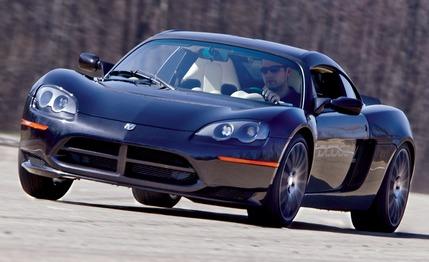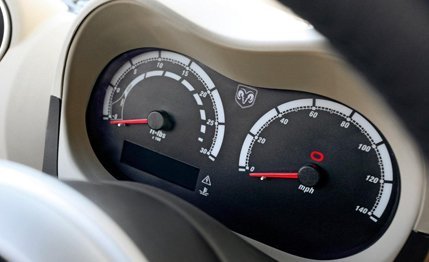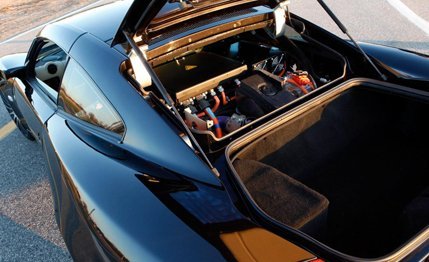
 First Drive Review
First Drive Review
Automakers aren’t usually receptive to the idea of us driving their concept cars, as most of these are little more than million-dollar auto-show paperweights that may not even move under their own power. The case of the Dodge Circuit EV, however, is different. Lou Rhodes, president of Chrysler’s electric-car ENVI division, had no qualms about giving us the first chance to wring the neck of this electric-powered sports car on a road course—the 1.7-mile handling loop at the company’s proving ground in Chelsea, Michigan.
Shown last fall for the first time, the Circuit is a not-sold-here Lotus Europa (itself a slightly swollen version of the Elise) that’s had its powertrain replaced with a 268-hp, 295-lb-ft electric motor and a large, 35-kilowatt-hour lithium-ion battery pack. Comparisons with the Lotus Elise–based Tesla roadster are inevitable.
When looking for a place to dock a 600-pound battery pack, a front-engine platform is all wrong from the perspective of weight distribution. And finding a mid-engine chassis from a manufacturer that will entertain inquiries for low-volume orders quickly trims the options down to one: Lotus. Its lightweight Elise and Exige S sports cars provide a tiny annual sales footprint in the U.S. (less than 2000 units), but the company is set to expand with its larger, more passenger-friendly Evora.
Rhodes touts the versatility of electric powertrains: A lower-power version of the Circuit’s motor can be shared with various other mainstream vehicles such as the Chrysler Town & Country minivan and the Jeep Wrangler and Patriot; the company has well-sorted running prototypes of each. While the Circuit is battery-only, the other variants are of the range-extended electric variety, as in Chevy’s Volt, which is powered by an electric motor but has a gas engine onboard to generate electricity if needed, which prevents occupants from being marooned when the juice runs out.
Electric motors are very efficient (92 percent or so, compared with gasoline engines, at 30 percent), and depending on the specifics of exactly how the EPA will rate electric vehicles in the future, the Circuit will likely achieve an energy-equivalent fuel-economy rating of well over 100 mpg.
Aside from cost, downsides include lack of energy storage (the massive battery pack holds fewer kilowatt-hours than can be extracted from a single gallon of gas) and, therefore, range. With just a claimed 150 miles between time-consuming recharges—90 minutes to 12 hours, depending on the power source—the Circuit likely won’t be your only car. But the dexterity required to slither over the wide doorsills and into the Circuit’s low-flying cabin that’s tight for two pretty much dictates the limited appeal of the thing anyway.
Fortunately, it’s still an enthusiast’s feast from behind the wheel, starting with the delectably precise unassisted steering that conveys every road nuance. But the heavy battery pack and electric bits skew the weight bias even more to the rear, making the front end noticeably light under power, which further exacerbates the Dodge’s tendency toward understeer. And there’s no disguising the hundreds of pounds of additional weight; the Circuit has considerably more body roll than an Elise.
So what does 295 pound-feet of instant torque feel like in a 2650-pound sports car? Well, the current software tuning conservatively metes out only a portion of the maximum at launch so as not to allow any wheelspin. Power oversteer is also verboten at the moment, although we sincerely hope that a production version would let the driver decide whether to melt the tires. As with our women, we prefer that a powerful sports car be able to frighten us from time to time.
_______________________________________________

 The gauge on the left shows amps, which may become a source of bragging for the next generation.
The gauge on the left shows amps, which may become a source of bragging for the next generation.
_______________________________________________
Whacking the power pedal once the car is up to speed, however, delivers a realistic rendition of a gut-contorting sucker punch. The Circuit pulls strongly well past 60 mph, but as triple digits approach, the lack of gears causes acceleration to taper off far more dramatically than in a traditional sports car. Reaching 60 mph takes a claimed 4.7 seconds, although Rhodes says that will likely improve by half a second. Another bonus is that the Dodge’s liquid-cooled motor enables consistent power output, which one-ups the quick-to-overheat air-cooled unit of the Tesla roadster.
We’re glad to report that electrics dilute the fun factor far less than hybrids do. First off, battery regeneration while decelerating is dictated solely by throttle position instead of brake application in the Dodge, so unlike hybrids, brake-pedal feel remains firm and unpolluted. And the power delivery is linear and predictable, unlike the annoying surging and high-rpm droning that happens in CVT-equipped hybrids.
The only indication that the Circuit we drove wasn’t quite production ready was some light tire-to-fender rubbing during maximum-honk cornering situations. And neither the lack of a wailing engine nor a shifter with which to exploit it diminished the enjoyment or satisfaction of turning a quick lap. Perhaps daydreams of the next generation will adapt to include the high-pitched shriek of an electric motor up near its 13,500-rpm redline.
Will they build it? Officially, Chrysler says it is committed to electric vehicles and will launch a single model next year. But the evidence overwhelmingly suggests that Chrysler is planning to produce the Circuit. Rhodes let slip word of prototypes in Michigan, Arizona, and the U.K. If this were simply a corporate promotion, there would be no need to spend oodles on prototypes scattered around the world. He also has a well-thought-out production plan, where, just like Tesla’s roadster, the Circuit would be produced at the Lotus factory and then be shipped to a factory in the U.S. for installation of the electric components.
_______________________________________________

 Four hundred amps course through the Dodge during hard acceleration, and as many as 200 flow under regeneration, so fiddling with those wires is not recommended.
Four hundred amps course through the Dodge during hard acceleration, and as many as 200 flow under regeneration, so fiddling with those wires is not recommended.
_______________________________________________
If Chrysler squeaks through its financial mess, plan on living with the irony of this dainty, 100-mpg apex clipper following up Dodge’s other sports car, the brutish, politically incorrect Viper. Rhodes says Chrysler is eventually planning to sell 100,000 electric vehicles per year (spread over numerous platforms), which should drive down the cost of the electric components—such as the hugely expensive $25,000-plus battery pack—and enable the Circuit to be priced “tens of thousands less” than the $110,950 Tesla sports car.
The way we see it, it doesn’t much matter whether they’re powered by batteries or bee stings—the more pure-driving Lotus-based vehicles inhabiting our roads, the better. Start lobbying your local track now for a high-powered charging source.